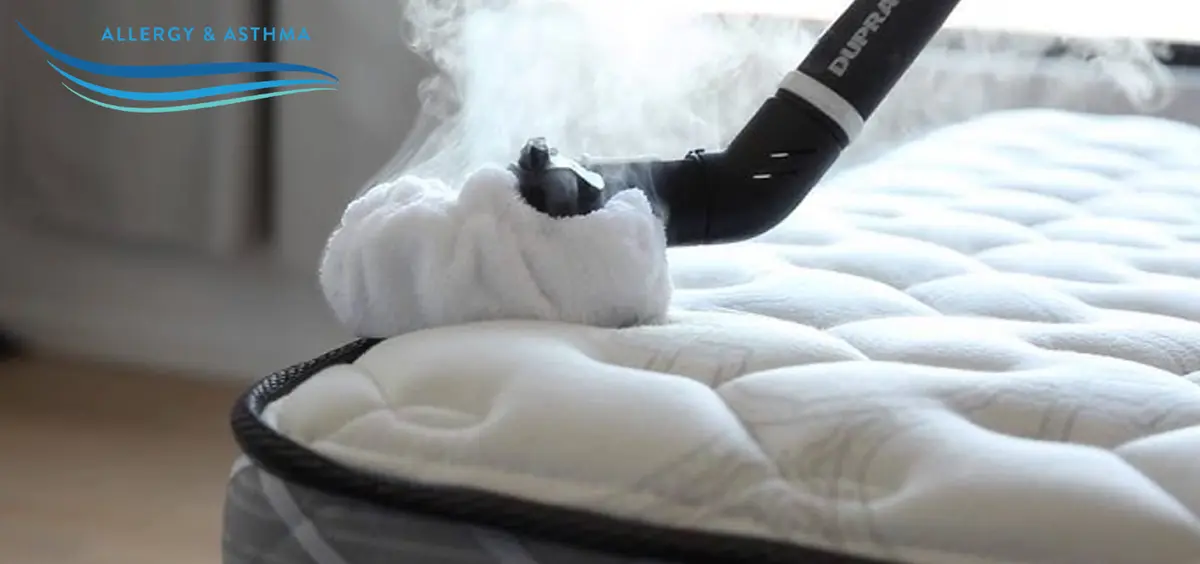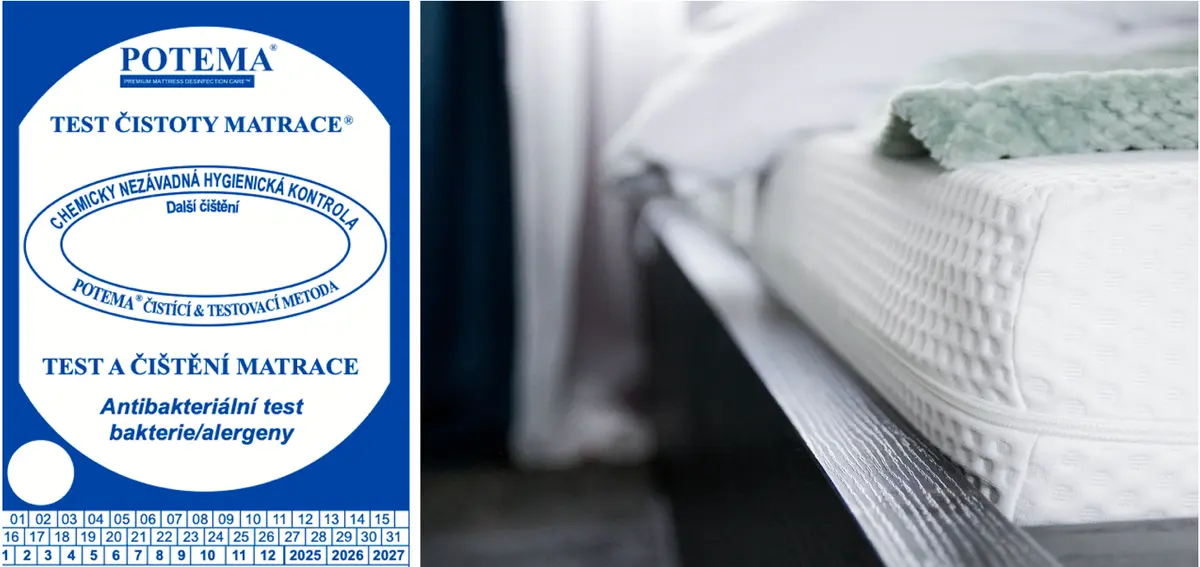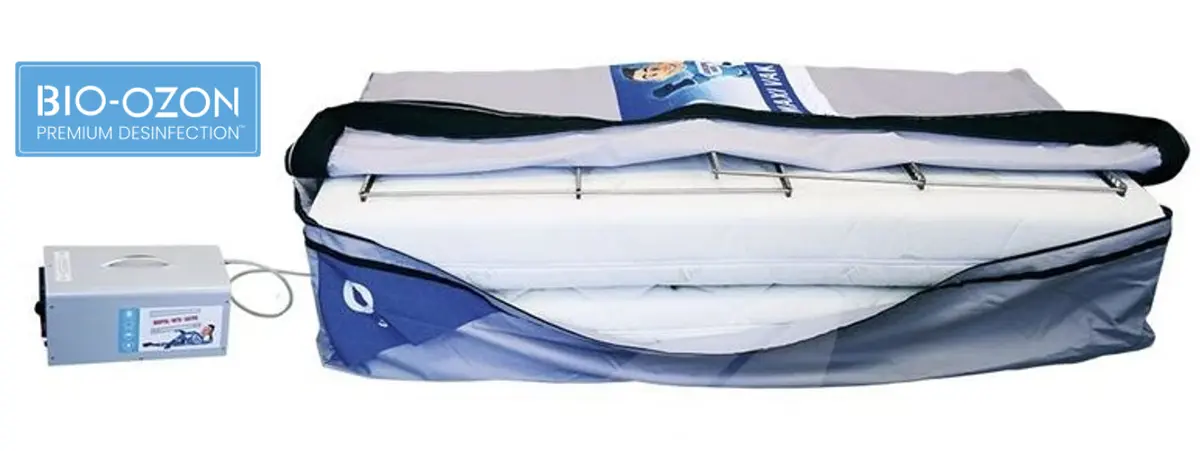Deep cleaning of mattresses
Deep mattress steam cleaning ensures that a clean and hygienic mattress is the key to a healthy and quality sleep. The mattress is where we spend up to a third of our lives, so it is essential to pay attention to deep cleaning and maintenance. Regular care not only extends the life of the mattress, but also prevents the accumulation of dust, bacteria, dust mites and allergens that can negatively affect our health. In this guide, we’ll look at detailed mattress deep cleaning instructions, recommended methods, necessary tools, as well as tips on how to keep your mattress clean and fresh for longer.

The  trade mark POTEMA® defines the branded technology concept of a professionally qualified Carpet Service® implementation company dedicated to the regular maintenance, cleaning, disinfecting, impregnation of synthetic, natural, wool, silk and American-made mattresses, beds and textiles. This branded concept delivers the utmost professionalism in full synergy with maintaining ethical, environmental and quality performance standards, including a contractual guarantee of contractor services.
trade mark POTEMA® defines the branded technology concept of a professionally qualified Carpet Service® implementation company dedicated to the regular maintenance, cleaning, disinfecting, impregnation of synthetic, natural, wool, silk and American-made mattresses, beds and textiles. This branded concept delivers the utmost professionalism in full synergy with maintaining ethical, environmental and quality performance standards, including a contractual guarantee of contractor services.
Deep mattress cleaning is an important process that should not be overlooked. Careful maintenance, proper products and prevention can extend the life of a mattress and ensure a healthier and more restful sleep. Whether you choose natural or commercial products, the key is regularity and consistency.
Why it’s important to clean your mattress
Many people don’t realize how easily a mattress can accumulate dust, sweat, grease and dead skin cells, creating an environment for microbes and dust mites. These microscopic organisms can cause allergies, asthma or skin irritation. Deep cleaning your mattress not only improves hygiene, but also helps prevent unpleasant odors and promotes quality sleep. So having a clean mattress doesn’t just mean more comfort, it also means better health.
Health risks associated with a dirty mattress
A dirty mattress can contribute to a number of health problems. Among the most common are:
- Allergies and asthma: Dust mites, mold and dust can cause or worsen allergic reactions and asthma symptoms.
- Skin problems: Bacteria, sweat and oils from the skin can contribute to rashes and other skin problems.
- Sleep disturbances: Unpleasant odors or the knowledge that you are sleeping on an unclean mattress can affect sleep quality.
That’s why it’s important to not only clean your mattress regularly, but also focus on preventing harmful organisms and mold.
How often to clean your mattress
The frequency of deep cleaning a mattress depends on various factors such as the type of mattress, the method of use, the room environment and specific needs (such as allergies). In general, a few basic rules apply:
- Light deep cleaning (such as vacuuming) should be done at least once a month.
- Deeper deep cleaning should take place at least once every six months.
- Deep cleaning after soiling (for example, after spilling liquids or if the mattress becomes a source of unpleasant odor) should be done immediately.
Regular deep cleaning is especially important for people with allergies or asthma, as it can help reduce the amount of allergens in the mattress.

Procedure for regular home mattress deep cleaning
Remove all fabric
The first step is to take off all textiles, such as mattress covers, sheets and blankets. It’s best to wash all these fabrics according to the manufacturer’s instructions to keep them clean and fresh.
Dry the mattress surface
Use a vacuum cleaner to thoroughly vacuum the entire surface of the mattress, including the sides. It is recommended to use a vacuum cleaner with a HEPA filter, which is more effective at trapping allergens and fine particles. This step is essential to remove dust, dust mites and small dirt particles.
Use baking soda or antibacterial cleaner
POTEMA® cleaner spray or baking soda is ideal for neutralizing odors. Spray or sprinkle the entire surface of the mattress with baking soda and leave it on for at least 15 to 30 minutes.
Vacuum again
After the baking soda has had time to absorb odors, vacuum the mattress thoroughly again. This step will help remove the baking soda residue and any loose particles.
Surface disinfection
At the end of the process, you can spray the mattress with a mild disinfectant spray that is suitable for fabrics. This step is optional, but is especially recommended if you want to keep the mattress as hygienic as possible.
Removing stains from the mattress
Stainings on a mattress can arise in a variety of ways – from spilled drinks, sweat, bodily fluids, to a variety of other causes. Each type of stain requires a different approach. Here are a few common approaches:
Sweat and body oil stains
Sweat and body oils build up over time, and if not cleaned regularly, can cause a yellowish discoloration on your mattress. You can use a mixture of baking soda, water and mild soap to remove these stains. Mix these ingredients and apply them to the stains with a sponge. Then wipe the mattress lightly with a damp cloth and let it dry.
Drink spills
If you spill liquid on your mattress, it’s important to act quickly. First, blot the liquid with a paper towel or clean cloth. Then use a mixture of water and vinegar (1:1 ratio) and gently tap the stain to clean it. Finally, use baking soda to neutralize the odor and vacuum it after it has dried.
Bloodstains
A mixture of cold water and salt or hydrogen peroxide is effectivefor removing blood stains. Gently dab the stain with a cloth dipped in the solution and then wipe with a damp cloth. It is important not to use hot water, which can set the stain.
Mold and odour
If mould appears on the mattress, extra care should be taken. A mixture of vinegar and water can help remove mould, but in some cases it may be necessary to use a special mould treatment. Mould can be harmful to health, so it is important to dry the mattress in the sun or in a well-ventilated room.
Despite regular care and deep cleaning, every mattress has a lifespan. If a mattress is more than 8-10 years old or shows signs of damage, odor, mold or allergic reactions, it may be time to replace it.
Procedure for professional mattress deep cleaning

The mattress is one of the most important elements of our home, having a major impact on our health, well-being and quality of sleep. When choosing a mattress, we pay close attention to its material, hardness and ability to adapt to the shape of the body. Unfortunately, we often forget that we also need to care for and clean the mattress regularly. Although many people don’t realise it, a mattress can become an ideal environment for dust mites, bacteria, mould and other dirt. In this text, we’ll explain why regular mattress cleaning is important, what your options are, and how to choose the best mattress cleaner.
Mattress Vacuuming & Knocking: Professional vacuums with a HEPA filter and HEPA bag must have an electric vibrating knocking head. This technology of KIRBY® / HYLA® vacuum cleaners makes it possible to remove surface mold spores, dust mites by dry method from the mattress surface.
Cleaning with special chemical cleaners: Professional antibacterial disinfectants and cleaners from the manufacturer and brand POTEMA® / Dr. Schutz® bring an environmentally friendly, anti-allergenic way to disinfect mattress surfaces.
UV-C lamp: We recommend entrusting your mattress to industry professionals who have a UV-C germicidal mattress lamp. UVC-producing lamps are designed to be safely used on mattress surfaces and other household items. The radiant energy of the UVC radiation acts directly on microorganisms that reside on the surface and top layer of the mattress. The disinfection process usually takes several minutes, during which time the lamp kills up to 99.9% of the bacteria and other harmful organisms present.
 OZON: We recommend entrusting your mattress to industry professionals who have the BIO-OZON® vacuum cleaning system. The disinfecting properties of ozone result from its ability to oxidize molecules in the cells of bacteria, viruses and other microorganisms. When ozone comes into contact with these pathogens, it disrupts the cell membrane or wall of the microorganism, leading to its decomposition and subsequent death. This process works similarly to the action of conventional disinfectants, but without the use of chemicals, which is beneficial for people who prefer natural and eco-friendly solutions.
OZON: We recommend entrusting your mattress to industry professionals who have the BIO-OZON® vacuum cleaning system. The disinfecting properties of ozone result from its ability to oxidize molecules in the cells of bacteria, viruses and other microorganisms. When ozone comes into contact with these pathogens, it disrupts the cell membrane or wall of the microorganism, leading to its decomposition and subsequent death. This process works similarly to the action of conventional disinfectants, but without the use of chemicals, which is beneficial for people who prefer natural and eco-friendly solutions.
In indoor applications such as mattress cleaning, ozone not only kills bacteria and viruses, but also mites, mold spores and other allergens. Its ability to destroy harmful microorganisms without toxic residues makes it ideal for the environment in which we sleep and rest.
Allergens, mold spores, bacteria, viruses and dust mites are not only a hygiene problem in mattresses, but also a health problem. But with proper prevention, maintenance and the right choice of mattress, the risks can be significantly reduced. Even the thickest sheets and blankets cannot protect us from micro-particles. Dust mites or moulds, which often number up to one million and produce allergy-causing faeces that settle in our mouths, noses, eyes, etc. every time we move. In addition to the allergy manifesting as itching, mucous membrane inflammation, bronchitis, asthma and shortness of breath can be added. This condition can be prevented by professional cleaning and deep dry disinfection thanks to UV-C radiation or vacuum ozonation of the mattress with thorough machine vacuuming and above all regular maintenance.
Tips for keeping your mattress clean
Besides regular vacuuming, there are several steps you can take to keep your mattress clean for as long as possible.
- Ventilate your bedroom regularly
Fresh air helps evaporate moisture from the mattress and reduces the appearance of mold and dust mites. - Use a mattress protector
- A mattress protector is easy to wash and can help protect your mattress from dust and stains.
- Wash your mattress regularly
Regular vacuuming helps remove surface dirt and keep the mattress hygienically clean. - Rotate the mattress
If possible, rotate the mattress regularly to ensure even wear and to prevent sagging in one spot. - Do not expose the mattress to moisture
Avoid excessive humidification to prevent the mattress from developing mould.
Download
Technical sheet POTEMA® (PDF)
Technical sheet VIROBAG® (PDF)